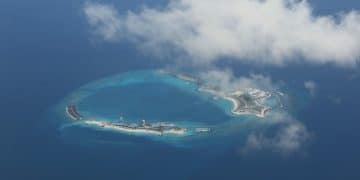Climate Change Impact on US National Security: A Geopolitical Analysis

Analyzing the impact of climate change on US national security involves understanding the complex ways in which environmental shifts exacerbate existing threats and create new challenges for American geopolitical strategy.
The intersection of climate change and national security has become a critical area of concern for the United States. Analyzing the impact of climate change on US national security: a geopolitical perspective reveals the intricate connections between environmental instability and geopolitical stability, highlighting the challenges and strategic implications for the nation.
Climate Change as a National Security Threat
Climate change is increasingly recognized not merely as an environmental issue but as a significant threat to national security. The effects of climate change, such as rising sea levels, extreme weather events, and resource scarcity, can destabilize regions, exacerbate conflicts, and create humanitarian crises. These impacts directly affect US interests both domestically and internationally.
Understanding the Direct Impacts
The direct impacts of climate change on US national security are multifaceted, ranging from infrastructure damage to increased demands on military resources.
- Rising sea levels threaten coastal military installations and naval bases.
- Extreme weather events strain emergency response capabilities and require military intervention.
- Increased demand for humanitarian assistance due to climate-related disasters.
Geopolitical Implications of Climate Change
The geopolitical implications of climate change are equally profound, altering the dynamics of international relations and creating new security challenges.
Climate change acts as a threat multiplier, exacerbating existing tensions and conflicts in already unstable regions. Resource scarcity can lead to competition and conflict, particularly in areas dependent on agriculture or water resources. Mass migrations caused by climate-related disasters such as droughts and floods can create further instability and strain the resources of neighboring countries.
In conclusion, climate change introduces a range of complex challenges to US national security, necessitating a strategic realignment of resources and policy to address these emerging threats.

Climate Change and Resource Scarcity
One of the most significant ways climate change impacts national security is through resource scarcity. Shifts in weather patterns and environmental conditions can lead to decreased agricultural output, water shortages, and other forms of resource depletion. These shortages not only affect the populations directly impacted but also have broader geopolitical implications.
The Nexus of Water, Food, and Security
The intersection of water, food, and security is particularly critical. Water scarcity, for example, can lead to conflicts between communities, regions, and even nations. Decreased agricultural yields can result in food insecurity, driving migration, and social unrest.
Climate Change and Migration
Climate-induced migration is another area of concern. As regions become uninhabitable due to rising sea levels or extreme heat, populations will be forced to move, creating large-scale migration flows that can overwhelm the resources of receiving countries and lead to political instability.
Furthermore, the stress on resources can exacerbate existing political and ethnic tensions within countries, potentially leading to civil unrest and even armed conflict. Such instability can create opportunities for extremist groups and transnational criminal organizations to thrive, further undermining regional security.
In summary, resource scarcity driven by climate change presents a significant threat to global stability, requiring proactive measures to mitigate these risks and promote sustainable resource management.
The Arctic and Emerging Security Dynamics
The Arctic is a prime example of how climate change is reshaping the geopolitical landscape. As ice melts and sea lanes open, the region is becoming increasingly accessible, sparking interest and competition among various nations.
Strategic Importance of the Arctic
The strategic importance of the Arctic stems from several factors, including newly accessible shipping routes, vast reserves of untapped natural resources, and its proximity to major geopolitical players.
The US Security Interests in the Arctic
The US has significant security interests in the Arctic, including protecting its territorial sovereignty, ensuring freedom of navigation, and preventing conflict in the region.
- Increased naval activity due to new shipping lanes.
- Competition for resources among Arctic nations.
- Potential for military build-up and heightened tensions.
Moreover, melting permafrost in the Arctic releases methane, a potent greenhouse gas, further accelerating climate change and creating a feedback loop that exacerbates the problem. This contributes to the overall global climate crisis and necessitates a coordinated international response.
In conclusion, the Arctic exemplifies the complex intersection of climate change, resource competition, and national security, demanding careful management to avoid escalating conflicts and ensure sustainable development.

Adapting Military Strategy to Climate Change
Given the profound impacts of climate change on national security, adapting military strategy is essential for the US Armed Forces. This involves assessing vulnerabilities, modifying operational plans, and investing in capabilities suited for a climate-altered world.
Assessing Vulnerabilities
Assessing vulnerabilities is the first step. Military installations, supply chains, and operational plans must be evaluated to identify potential weaknesses in the face of climate-related threats.
Integrating Climate Considerations into Planning
Integrating climate considerations into planning processes is equally important. This includes factoring in the likelihood of extreme weather events, resource scarcity, and population displacement when developing military strategies and contingency plans.
In addition to strategic adjustments, the military can also play a role in reducing its own carbon footprint through investments in renewable energy, energy-efficient technologies, and sustainable practices. The military can lead by example in promoting environmental stewardship and reducing the overall impact of its operations.
- Investing in resilient infrastructure and technologies.
- Modifying training programs to address climate-related scenarios.
- Enhancing partnerships with international allies on climate security issues.
In essence, adapting military strategy to climate change requires a comprehensive approach that integrates environmental factors into every aspect of military planning and operations. These adaptations are crucial for ensuring the continued effectiveness and readiness of the US Armed Forces in a rapidly changing world.
Economic Impacts of Climate Change on National Security
The economic impacts of climate change also have significant implications for US national security. Climate change can disrupt global supply chains, increase the cost of disaster relief, and undermine economic stability in countries that are critical to US interests.
Disrupting Global Supply Chains
Disruptions to global supply chains can have far-reaching consequences, affecting the availability of critical resources, increasing prices, and undermining economic competitiveness.
Increasing Costs of Disaster Relief
The rising frequency and intensity of climate-related disasters are placing an increasing burden on US taxpayers, diverting resources from other important priorities, such as education, infrastructure, and healthcare. For example, the cost of responding to hurricanes, floods, and wildfires has soared in recent years, straining government budgets and requiring significant financial investments.
Furthermore, the economic costs of climate change are not limited to direct disaster relief. Indirect costs, such as decreased agricultural productivity, damage to infrastructure, and loss of tourism revenue, can also have a significant impact on national economies.
In conclusion, the economic impacts of climate change pose a substantial threat to US national security. Addressing these economic risks requires a comprehensive strategy that combines mitigation efforts, adaptation measures, and international cooperation to foster economic resilience and sustainable development.
International Cooperation and Climate Security
Addressing the security implications of climate change requires robust international cooperation. Climate change is a global challenge that transcends national borders, and no single country can effectively address it alone. Working with allies, partners, and international organizations is essential for developing effective strategies and sharing the burden of addressing climate-related security threats.
- Developing common frameworks for assessing climate security threats.
- Sharing best practices and lessons learned on adaptation strategies.
- Coordinating efforts to provide humanitarian assistance to climate-affected regions.
International Agreements
International agreements, such as the Paris Agreement, provide a framework for collective action on climate change, setting targets for emissions reductions and mobilizing financial resources to support adaptation efforts in developing countries.
In addition to formal agreements, informal partnerships and networks are also essential for promoting international cooperation on climate security. These networks can facilitate the exchange of information, promote joint research, and coordinate responses to climate-related crises.
In summary, international cooperation is paramount for addressing the security implications of climate change, requiring a concerted effort to build consensus, share resources, and develop effective strategies for mitigating and adapting to this global threat.
| Key Point | Brief Description |
|---|---|
| 🌊 Rising Sea Levels | Threaten coastal military bases and infrastructure. |
| 🔥 Resource Scarcity | Exacerbates conflicts due to limited water and food. |
| 🌍 Arctic Changes | Opens new strategic routes, increasing geopolitical competition. |
| 🤝 International Cooperation | Essential for effective climate security strategies. |
FAQ
Climate change affects military readiness through damage to infrastructure from extreme weather, increased demand for disaster relief, and the need to adapt to new operational environments in regions affected by climate change.
The Arctic is a critical region as melting ice opens new sea lanes and resource opportunities, escalating geopolitical competition and requiring strategic monitoring and management by the US to protect its interests.
The US military can reduce its carbon footprint by investing in renewable energy sources, improving energy efficiency, and implementing sustainable practices across its operations and supply chains.
The Paris Agreement provides a global framework for reducing greenhouse gas emissions and supporting adaptation efforts, promoting international cooperation to mitigate climate change’s security implications.
Climate change heightens global instability by exacerbating resource scarcity, driving mass migrations, and increasing the frequency of extreme weather events, which can lead to conflicts and humanitarian crises.
Conclusion
In conclusion, analyzing the impact of climate change on US national security: a geopolitical perspective underlines the urgent need for proactive strategies to mitigate risks and enhance resilience. Addressing these challenges requires integrating climate considerations into military planning, fostering international cooperation, and investing in sustainable solutions to ensure the nation’s security and stability in a changing world.





